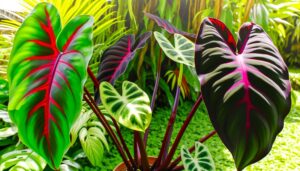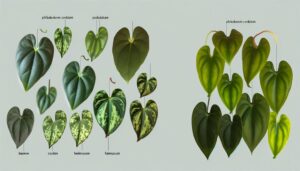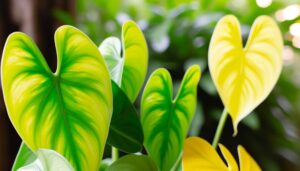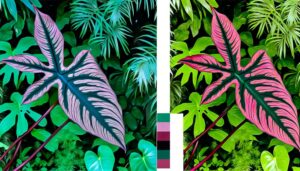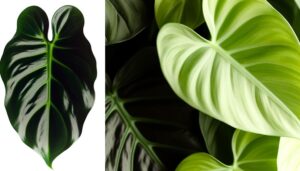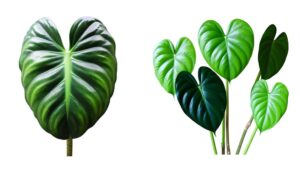Philodendron Green Princess Vs Green Congo: Quick Comparison
Philodendron Green Princess and Green Congo, both from South America’s rainforests, thrive in humid, shaded environments. The Green Princess has glossy, oval-shaped leaves with a deep emerald hue, favoring indirect light.
In contrast, the Green Congo’s broader, leathery, lighter green leaves prefer brighter areas. Green Princess tends to climb, requiring support, whereas Green Congo grows upright and bushy.
Both require moist, well-drained soil and monitored watering to avoid root rot. Understanding their distinct leaf structures, light preferences, and growth habits helps in selecting the right plant for your space.
Continue to explore their maintenance for best health.
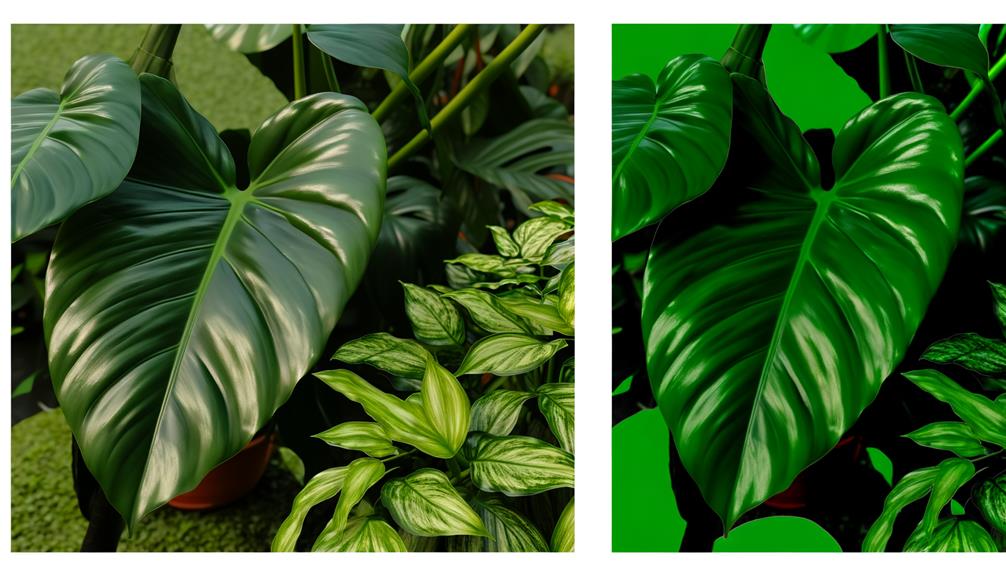
Key Takeaways
- Green Princess has deep emerald, oval-shaped glossy leaves; Green Congo has lighter green, broader, leathery leaves.
- Green Princess displays a climbing habit, requiring support; Green Congo is upright and bushy.
- Green Princess thrives in indirect light; Green Congo prefers brighter light conditions.
- Green Princess has a more compact growth; Green Congo features elongated, lanceolate leaves.
- Both species need moist, well-draining soil, but overwatering can cause root rot.
Philodendron Green Princess vs Green Congo: Key Differences
| No. | Feature | Philodendron Green Princess | Philodendron Green Congo |
|---|---|---|---|
| 1 | Leaf Color | Solid deep green | Glossy, deep green |
| 2 | Growth Rate | Moderate | Fast |
| 3 | Price Range (USD) | $20 – $50 | $30 – $100 |
| 4 | Size (Mature Height) | Up to 1 meter | Up to 1.2 meters |
| 5 | Availability | Common | Common |
| 6 | Watering Needs | Moderate | Moderate |
| 7 | Light Requirements | Bright, indirect light | Bright, indirect light |
| 8 | Care Difficulty | Easy to moderate | Easy |
Origin and Background
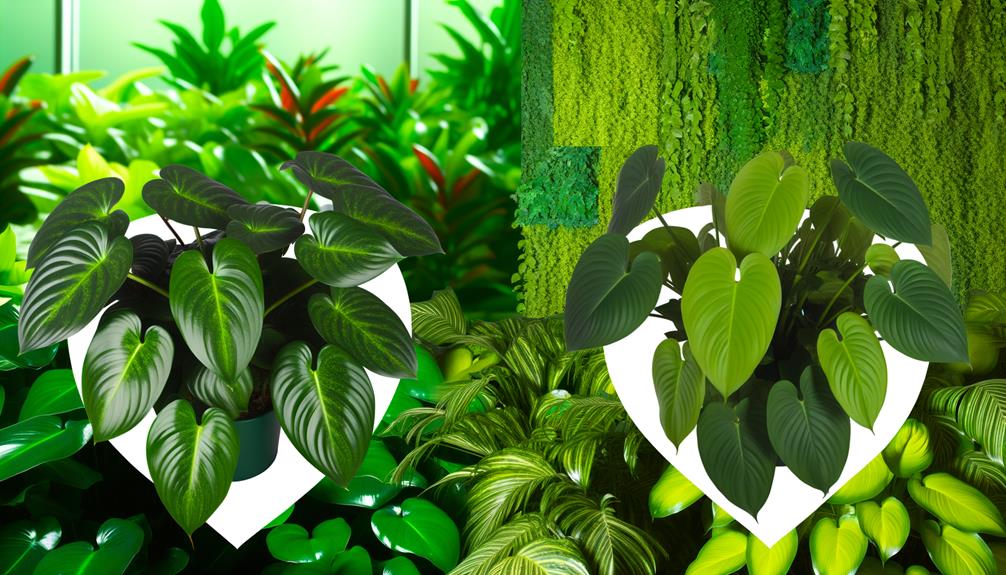
The Philodendron Green Princess and Green Congo, both part of the Araceae family, originate from the tropical rainforests of South America where they thrive under the canopy cover. These regions provide a humid, shaded environment essential for their growth.
The Green Princess is typically found in underbrush layers, benefiting from filtered sunlight, while the Green Congo often inhabits higher elevations within the forest strata. Understanding their origin is crucial for successful cultivation.
Mimicking their native habitat—maintaining high humidity, indirect light, and well-draining soil—ensures peak health. Furthermore, these species thrive in temperatures ranging from 18-25°C (65-77°F), necessitating careful indoor climate control.
This background knowledge aids in replicating the natural conditions that these plants have adapted to over millennia.
Leaf Structure and Color
In comparing the leaf structure and color of Philodendron Green Princess and Green Congo, it is essential to examine their distinctive shape and texture, color variations, and growth patterns.
The Green Princess typically exhibits oval-shaped, glossy leaves with a darker green hue, whereas the Green Congo is characterized by broader, more leathery leaves with a lighter green tone.
Understanding these differences can aid in selecting the appropriate plant for specific aesthetic and environmental preferences.
Shape and Texture
Philodendron Green Princess exhibits a more elongated leaf shape with a glossy, dark green hue, whereas Green Congo features broader, paddle-shaped leaves with a matte finish.
The Green Princess’s leaves are lanceolate, characterized by their tapering ends and smooth, reflective surface, which can enhance light absorption efficiency.
In contrast, Green Congo’s leaves are ovate, providing a more substantial surface area that aids in maximizing photosynthetic activity. The matte texture of Green Congo minimizes water loss through transpiration by reducing surface reflection, making it more drought-resistant.
When choosing between the two, consider the Green Princess for spaces requiring a more decorative, glossy appearance, and opt for Green Congo in environments demanding robust, water-efficient foliage.
Color Variations
Diverging in their leaf structure and color, the Green Princess showcases a deep, emerald hue with intricate vein patterns, while the Green Congo exhibits a lighter, more uniform green with less pronounced veining.
The Green Princess’s leaves are distinguished by their vibrant chlorophyll concentration, enhancing their rich coloration and elevating their aesthetic appeal. In contrast, the Green Congo’s foliage presents a more muted palette, attributed to its broader leaf structure and lower vein prominence.
For horticulturalists, understanding these distinctions is pivotal in selecting the appropriate species for specific lighting conditions and decorative purposes.
The Green Princess thrives in indirect light, which accentuates its dark tones, whereas the Green Congo is better suited for brighter areas, highlighting its lighter green foliage.
Growth Patterns
Understanding the growth patterns of the Green Princess and Green Congo philodendrons requires a detailed examination of their leaf structure and color development. Both varieties exhibit distinct characteristics that influence their overall appearance and care requirements.
- Leaf Structure: Green Princess philodendrons feature smaller, more oval-shaped leaves with a glossy texture, while Green Congo philodendrons have larger, elongated leaves with a somewhat leathery feel.
- Color Development: Green Princess leaves tend to maintain a consistent dark green hue, whereas Green Congo leaves often display gradient shades of green, intensifying as they mature.
- Growth Habit: Green Princess grows more compactly, suitable for tabletop displays, whereas Green Congo exhibits a more upright and robust growth, ideal for floor placement.
These differences inform the most suitable placement and care strategies for each plant.
Growth Habit

The growth habits of Philodendron Green Princess and Green Congo exhibit distinct characteristics that influence their cultivation. Green Princess typically has a more compact form with smaller, heart-shaped leaves, and it can be trained to climb if provided with support.
Green Congo, on the other hand, grows upright with larger, elongated leaves. Understanding their light and water requirements is essential for optimizing their growth, with both species thriving in bright, indirect light and requiring moderate watering to maintain soil moisture without waterlogging.
Leaf Shape and Size
When examining the leaf shape and size of Philodendron Green Princess and Green Congo, one observes distinct morphological differences that influence their respective growth habits.
The Green Princess features smaller, ovate leaves that exhibit a glossy texture, while the Green Congo’s leaves are larger and more elongated, presenting a robust and leathery appearance. These variances contribute to their unique aesthetic and practical considerations in cultivation.
- Green Princess: Compact, rounded leaves, typically measuring 4-6 inches in length.
- Green Congo: Elongated, lanceolate leaves, reaching up to 12-18 inches.
- Glossy vs. Leathery: Green Princess leaves have a high sheen, whereas Green Congo’s leaves are more matte and substantial.
Understanding these differences aids in selecting the appropriate species for specific interior spaces.
Climbing Vs. Upright
In addition to their leaf morphology, Philodendron Green Princess and Green Congo also exhibit distinct growth habits, with the former displaying a climbing tendency and the latter maintaining an upright posture.
The Green Princess, characterized by its vining nature, often requires support structures such as trellises for best growth.
This climbing habit allows for vertical space utilization, making it suitable for compact indoor environments.
Conversely, the Green Congo grows upright, forming a bushy appearance that can serve as a focal point in interior decor. This distinction in growth habits necessitates varied maintenance strategies.
| Plant Type | Growth Habit | Support Requirements |
|---|---|---|
| Green Princess | Climbing | Requires support (trellis) |
| Green Congo | Upright | Self-supporting |
| Maintenance Strategy | Vertical growth | Bushy, focal decor |
Light and Water Needs
Understanding the distinct light and water requirements of Philodendron Green Princess and Green Congo is essential for maximizing their respective growth habits and overall health.
The Green Princess thrives in bright, indirect light, while the Green Congo can tolerate lower light conditions but performs best under moderate, filtered light.
Both species necessitate consistent moisture but are sensitive to overwatering. To ensure peak hydration:
- Philodendron Green Princess: Keep the soil consistently moist but not waterlogged, allowing the top inch to dry slightly between waterings.
- Philodendron Green Congo: Allow the soil to dry out more between waterings, ensuring it remains slightly more arid compared to the Green Princess.
- General Tip: Employ a well-draining potting mix to prevent root rot and facilitate appropriate water retention and aeration.
Light Requirements
Philodendron Green Princess and Green Congo both flourish under bright, indirect light, although they can tolerate lower light conditions with varying degrees of success. Best photosynthetic activity occurs when these plants receive filtered sunlight, mirroring their natural understory habitat.
Excessive direct light can result in chlorosis and leaf burn, compromising overall health. Conversely, inadequate light may lead to etiolation, characterized by leggy growth and reduced leaf pigmentation.
For indoor cultivation, situating these philodendrons near an east or north-facing window guarantees adequate luminosity without the risk of photodamage.
Supplemental artificial lighting can also be utilized, using full-spectrum grow lights to maintain photosynthetic efficiency. Monitoring light conditions and adjusting accordingly is vital for sustained vigor and aesthetic appeal.
Watering Needs
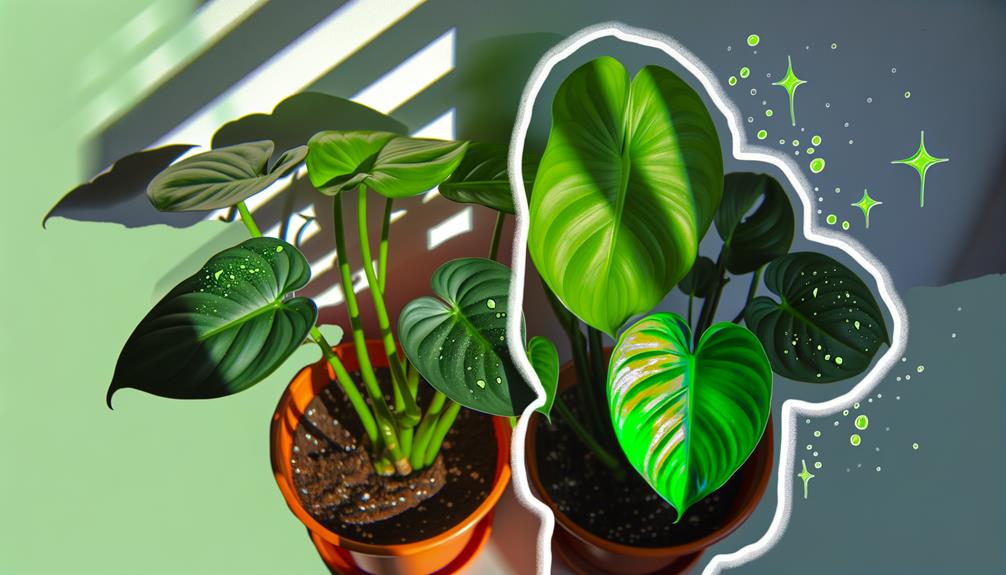
Proper hydration is essential for the best growth and health of both the Philodendron Green Princess and Green Congo, requiring a balanced approach to watering frequency and volume. These tropical plants thrive in moist, well-draining soil but are sensitive to overwatering, which can lead to root rot.
Key considerations include:
- Soil Moisture: Consistently monitor soil moisture using a moisture meter, ensuring the top inch of soil dries out between waterings.
- Water Quality: Utilize distilled or rainwater to avoid chemical buildup from tap water, which can harm the roots.
- Watering Schedule: Adjust watering frequency according to seasonal changes; reduce during winter dormancy and increase during the growing season.
Adhering to these guidelines will support ideal hydration and promote vigorous plant development.
Common Pests and Issues
Despite ideal watering practices, the Philodendron Green Princess and Green Congo can still be vulnerable to common pests and issues such as spider mites, aphids, and fungal infections. Spider mites often appear as tiny, web-like structures on the underside of leaves.
Aphids can lead to leaf curling and yellowing due to their sap-sucking behavior. Fungal infections, including root rot, are typically a result of overwatering and poor soil aeration.
Implementing a regular inspection routine and maintaining best humidity levels can help alleviate these problems. Treat infestations with insecticidal soap or neem oil and promote good air circulation to prevent fungal growth.
Quarantine new plants before incorporating them into your collection to avoid introducing pests and pathogens.
Conclusion
To sum up, the Philodendron Green Princess and Green Congo exhibit unique features in leaf formation, growth pattern, light preferences, and watering necessities.
For example, a controlled greenhouse investigation revealed that the Green Congo flourished in moderate indirect sunlight, whereas the Green Princess displayed ideal development in bright, filtered light.
Recognizing these distinctions enables gardeners and plant lovers to customize care routines efficiently, thus improving plant well-being and visual appeal.
Accurate recognition and upkeep promote vigorous growth and mitigate vulnerability to typical pests and concerns.

